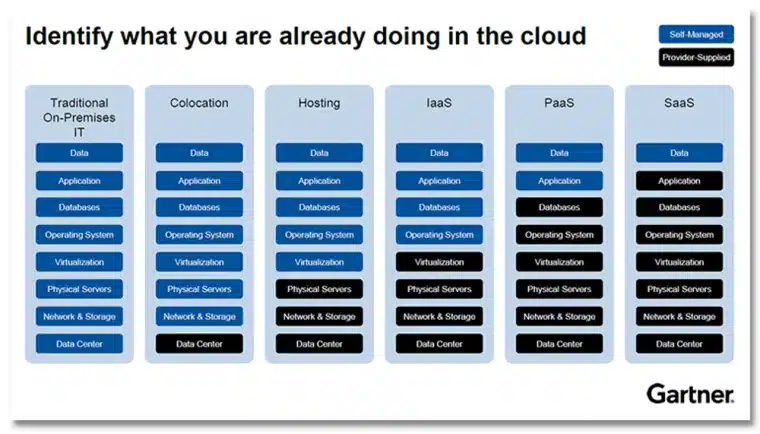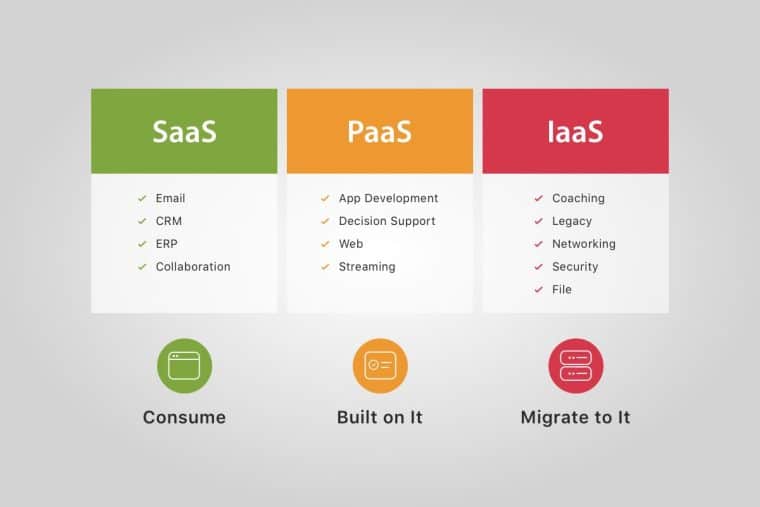The cloud computing revolution has forever changed the way businesses utilize computing services. Traditionally, businesses had to invest in costly servers to provide data storage and support their on-premise applications. But thanks to the cloud, service providers can now deliver applications and data via the internet, a process known as software as a service (SaaS).
True to form, the information technology industry has only continued to develop more cloud services, with providers devising different acronyms for each. Below, you’ll find all the details about the latest of these: the anything-as-a-service (XaaS) business model, also known as everything as a service.
What Is XaaS (Everything as a Service)?
“Anything as a Service” or Xaas is a broad term that covers several services and applications delivered over the internet instead of via on-site servers. The concept is rooted in cloud computing models, wherein almost any IT function or business process can be offered as a service.
In the early days of the “as a service” revolution, cloud providers focused on a handful of offerings, like specific SaaS solutions. Today, XaaS providers offer software, data storage, infrastructure, analytics tools, and many other digital resources as services. Altogether, the concept represents a shift from traditional models: Instead of buying and owning physical products or software, businesses now rent them on a subscription basis. As software and other digital resources continue to get better and more complex every year, it just doesn’t make sense for most companies to build their own solutions anymore.
With that in mind, the XaaS business model gives your organization greater flexibility and scalability while allowing you to get more value from your software investments. It is an approach that turns IT from a variable expense to a fixed cost, simplifying budgeting and helping you maintain healthier margins.
How XaaS Works
XaaS providers host applications, platforms, or infrastructure in centralized data centers. Clients can then access these centers and the computing resources they provide via the internet. The provider delivers various services on a subscription basis, offering flexibility and scalability, and the organizations that manage these data centers are responsible for maintaining their security and ensuring adequate uptime.
The subscription model is a foundational part of anything as a service. Users pay a recurring fee to access each service, and doing so offers financial flexibility. Capital expenses are shifted to operational expenses, allowing businesses to pay only for what they use without significant upfront investments.
Since users will access the center and its services via the internet, investing in on-premise hardware like servers or installing software directly on personal devices is no longer necessary. Instead, authorized users can access the services anywhere, anytime.
Consider the following example that breaks down the investment differences between on-premise and XaaS business models: Think back to the days before subscription streaming services like Netflix and Hulu. Building an extensive content library meant purchasing a DVD player and investing thousands in DVDs. Today, you can sign up for whichever subscription services have the content you like. You can add or remove subscriptions on-demand, drastically reducing your entertainment costs.
The same concept applies to XaaS. Your business can subscribe to the specific services it needs, such as applications, infrastructure, or storage. As its needs evolve, you can add other services or modules for a fixed fee, keeping your IT costs predictable and manageable.
Types of XaaS Models
Several cloud services fall under the XaaS umbrella.

Some of the most notable ones are as follows:
Software as a Service (SaaS)
The first (and perhaps most popular) of the many cloud service models is software as a service, which your business can use to integrate various products and applications into your tech stack. Using SaaS resources saves your company time and money, as you won’t have to develop your applications.
A few common examples of SaaS applications include Slack, Shopify, Salesforce, Dropbox, and Microsoft Office 365. Many businesses use dozens of SaaS tools at once. In fact, large organizations use 371 different SaaS applications on average.
Platform as a Service (PaaS)
A platform as a service provides an ecosystem through which you can create your software or tools. PaaS providers offer servers, storage space, computing resources, and more. The big appeal of the model is that it allows you to circumvent the costs associated with buying your hardware, such as servers and networking infrastructure.
Chances are that you are already partnered with a major cloud provider, as Windows Azure and Amazon Web Services Elastic Beanstalk are a couple of common examples of the concept.
Infrastructure as a Service (IaaS)
Infrastructure as a service is quite similar to PaaS in that it includes storage and computer power, which you can use to run and develop products. However, IaaS typically does not include middleware, which PaaS does.

You can think of PaaS as the ecosystem where you build your applications. IaaS, in that sense, refers to the resources you use to scale it. However, if you move your IT infrastructure to the IaaS provider network, any downtime or disruptions they experience will interfere with access to your IT resources.
Google Cloud, alongside the previously mentioned Azure and AWS, are a few well-known IaaS providers.
Analytics as a Service (AaaS)
When cloud providers advertise “anything as a service,” they mean it. With that in mind, analytics as a service is one of the newer additions to the XaaS ecosystem, and it involves licensing a data reporting solution from a third party.
AaaS providers offer tools that integrate with your business’s existing tech stack, allowing you to run detailed reports on everything from inventory to finances and gain actionable insights into the state of your business. With the right AaaS resources, you can take the guesswork out of decision-making and reach your company’s full potential.
Most of the top XaaS providers like Microsoft, Amazon, Google, and IBM offer various kinds of AaaS products like Amazon QuickSight or IBM Watson Studio.
Storage as a Service (STaaS)
If you’ve exhausted your on-premise storage capabilities, storage as a service might be a great addition to your XaaS ecosystem.
Doesn’t every cloud provider offer storage, though? The answer is yes, but they typically offer storage for data specific to your subscription. For instance, if you use a SaaS app, the provider generally just includes storage for application data.
Like other XaaS services, STaaS uses a subscription model to offer general storage for all your applications and computing tools. Under the framework, you’ll pay based on the storage you consume.
Database as a Service (DBaaS)
One last newly-emerging XaaS category is database as a service. With DBaaS solutions, you gain access to a pre-built cloud environment designed to store, organize, and access your data.
Before DBaaS, businesses had to build their databases from scratch, which is time, labor, and resource-intensive. Today, you can subscribe to a DBaaS solution, plug in your data, and set access rules to allow authorized personnel to view business information from anywhere.
The XaaS Market Landscape
As of 2022, the XaaS market was valued at $595.78B. And by 2032, it’s projected to reach a value of $3.96T, representing a compound annual growth rate (CAGR) of 20.77% during the ten-year forecast period.
Technically, any cloud services provider that offers multiple subscription solutions falls under the umbrella of XaaS. However, AWS, Microsoft Azure, and Google Cloud are the “big three” that dominate the XaaS landscape.
While businesses across a wide range of verticals have partnered with these entities and leaned into the XaaS model, a few sectors are leading the charge:
- Finance
- Healthcare
- Manufacturing
- E-commerce
- Software development
These industries have complex business infrastructure that requires the use of numerous applications and IT resources. The XaaS model is, therefore, particularly appealing, as it can meet many of their technology needs via one partner.
Benefits of Adopting an XaaS Model
The advantages of XaaS are plentiful, and they include all of the following:
Reduced IT Costs
If you are currently powering your business with numerous on-premise applications, an XaaS approach can offer huge cost savings. You’ll no longer need to maintain your IT infrastructure and server network, as you’ll be able to requisition applications, data, and resources on-demand via the internet.
Cutting back on IT costs will make your business leaner. And in turn, you will have more resources for other pursuits, such as upgrading equipment, hiring additional staff, or expanding to a secondary location. However, make sure that you don’t replace your IT system with an unsuitable one, as the cost of lost productivity could far outweigh the greater upfront cost of strong IT.
Subscription-Based Billing
Another huge benefit of the XaaS approach is that most providers bill on a subscription basis. You can pay for solutions monthly or annually, depending on the provider, which gives you a great deal of flexibility. And if you need to add-on services, simply adjust your subscription. You can integrate new modules into your IT framework in days, not months, while incurring minimal added costs.
Enhanced Scalability
The cloud offers virtually unlimited scalability. Your business will probably never outgrow the capabilities of the largest data centers, meaning you’ll have the freedom to acquire more data, add applications, and pursue new opportunities as they suit the needs of the company.
Since your costs only increase with your consumption, you shouldn’t experience huge spikes in IT expenses, either. Instead, your costs will increase gradually in line with the business itself.
Better Technical Support
Moving away from on-premise solutions to XaaS services shifts the burden of technical support onto the provider. They are responsible for maintaining uptime and will promptly respond to any technical issues.
Remember, the company offering the cloud services also has a direct interest in keeping you happy. Therefore, if you have questions about how to use the programs or need training resources for your team, the XaaS company will be happy to oblige.
Challenges and Considerations for XaaS Adoption
Despite the numerous benefits, there are some potential challenges involved with adopting XaaS technologies, such as:
Data Security and Privacy Concerns
Moving your data to the cloud can raise privacy concerns among some of your team members and customers. That said, the best cloud partners place a premium on security. After all, they don’t want to tarnish their reputations or lose clients’ trust over a data breach.
Vendor Lock-in
Once you and your team get accustomed to an application or IT resource, you may forget how to do business without it. That can give way to vendor lock-in, a feeling that you can’t part ways with a vendor because your organization has become so reliant on them. As such, you must choose the right partner before you build your entire digital infrastructure around their services.
Network Reliability
If a provider’s network goes down, it will impact your company’s ability to access its applications and data. Therefore, before entering into an agreement, determine the uptime a provider promises and ensure it aligns with your needs.
Organizational Change Management
Adopting new applications can strain your company and employees, so ensure you equip your staff to succeed by notifying them of what changes you are making, explaining why they are necessary, and offering training to get them up to speed. A confident staff will be more willing to embrace new technologies.
Is XaaS Right for Your Business?
If managing on-premise resources or working with dozens of providers have become IT pain points for your business, it might be time to embrace the anything-as-a-service model. You can drastically reduce your IT expenses, promote scalability, and decrease the burden on your in-house information technology team.
However, you can’t just dive into XaaS without a plan. Meet with your stakeholders, identify what you hope to achieve by moving to the cloud at scale, and execute.
XaaS Is the Future — Are You Ready?
Ultimately, anything as a service represents the next big leap in cloud-based technology and the delivery of computing resources to businesses. It offers numerous tangible benefits to your organization, staff, and customers, so it should be no surprise when businesses in key sectors increasingly rely on the XaaS approach.
If you want to stay competitive, you’ll likely need to follow suit. But keep in mind that you don’t have to go all-in overnight. Consider moving a handful of core processes or technologies to the cloud. Implementing changes in waves will give your team time to adapt and can keep you from feeling overwhelmed. Before you know it, you’ll be at the helm of an agile, cloud-powered business.
